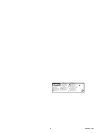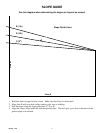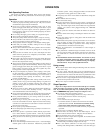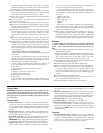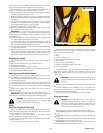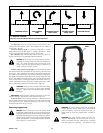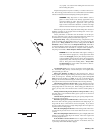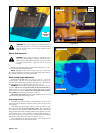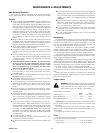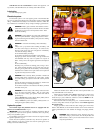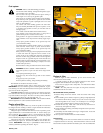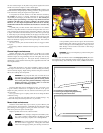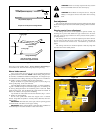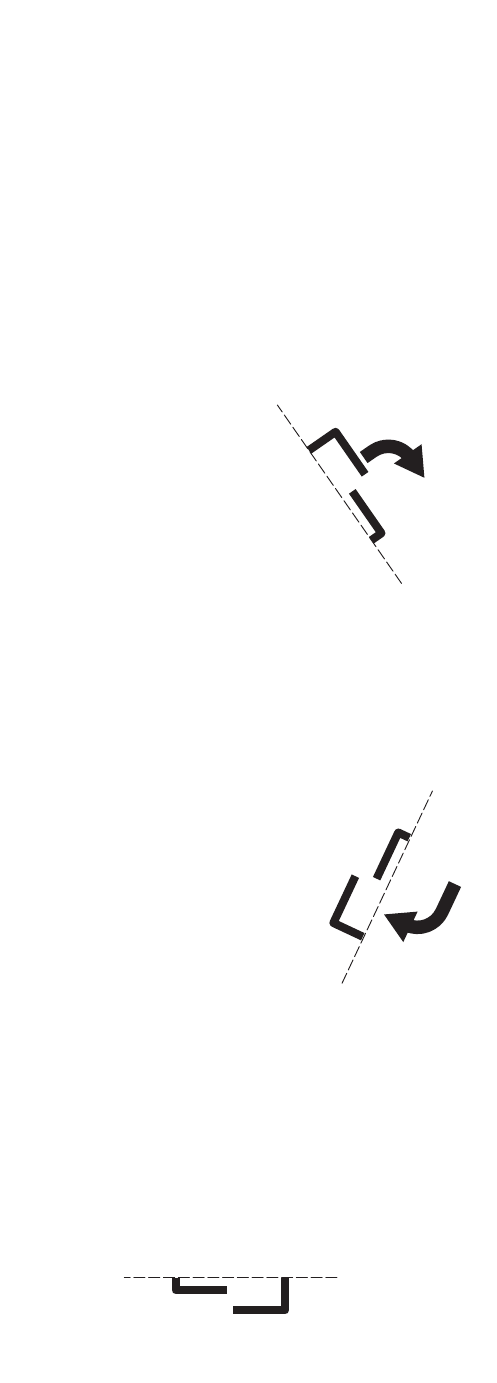
14 601457_1107
very rapidly. Use caution when making turns and slow down
before making sharp turns.
Inexperienced operators may have a tendency to oversteer and lose con-
trol. Slow-moving practice maneuvers are recommended to become familiar
with these characteristics before attempting normal speed operation.
WARNING: Sharp depressions or raised obstacles (such as
gutters or curbs) should not be directly approached at high
speed in an attempt to “jump” them as the operator could be
thrown from the equipment. Approach at a slow speed and
angle one drive wheel at the obstruction. Continue at an angle
until the wheel clears and then pivot the opposite wheel around.
When turning on soft wet turf, keep both wheels rolling either forward or
backward. Pivoting on one stopped wheel can damage turf. This is espe-
cially important when mowing.
Tractor performance is maximum when the throttle is set at full rpm.
This gives maximum power to the drive wheels and deck when needed. Use
the control levers to control ground speed rather than engine rpm.
Keep blades sharp. Many professional mowing companies have addi-
tional sets of blades and change blades twice a day: once in the morning and
again at noon. Many problems with incorrect cutting patterns are due to
dull blades or blades which have been sharpened incorrectly. Information
on sharpening blades is listed in this manual’s maintenance section. In addi-
tion, most communities have individuals or companies which specialize in
sharpening mower blades. Blade sharpness should be checked daily.
DANGER: Never work with blades while engine is running or
deck clutch switch is engaged (on). Always place deck clutch
switch in the disengaged position, place steering control levers
in the park brake position and turn engine off and disconnect
negative battery cable. Block up mower when you must work
under it. Wear gloves when handling blades. Always check
for blade damage if mower strikes rock, branch or other for-
eign object during mowing!
Use high blade speed. Your mower is designed to operate at full throt-
tle. The throttle setting directly controls blade speed. The highest blade
speed generally gives best cut.
Direct grass discharge to right, away from unmown area. Select a
mowing pattern that directs grass discharge towards the outside, not towards
center, of mowing area. Generally, this means using a pattern utilizing left
turns because side discharge is to right. In any case, avoid throwing grass
discharge onto unmowed area because grass is then mowed “twice”. Mowing
twice puts an unnecessary load on the unit and reduces mowing efficiency.
When mowing a lawn for the first time cut grass slightly longer than
normal to avoid scalping uneven terrain. When possible, it is best to use the
cutting height that was used in the past. When cutting grass taller than six
inches, you may want to mow the lawn twice to achieve a better quality of
cut.
During normal mowing cut only about 1/3 of the grass blade. Cutting
more than that is not recommended unless grass is sparse or it is the end of
the mowing season.
Alternate mowing direction to keep the grass growing straight and bet-
ter dispersion of the clippings.
Remember, grass grows at different rates at different time of the year.
Mow more often in the early spring to maintain the same cutting height. As
the growth rate slows in mid summer, mow less frequently. If you cannot
mow at a regular interval, mow at a high cutting height; then mow again two
days later at a lower cutting height.
Raise the cutting height of the mower if the cutting width of the mower
is wider than the previous mower. This ensures that uneven turf is not cut
too short.
Raise the cutting height of the mower if the grass if slightly taller than
normal or if it contains a high degree of moisture. Then mow it again with
the cutting height set lower.
If the machine’s forward motion must be stopped while mowing, a
clump of grass clippings may drop onto your lawn. To avoid this, move onto
a previously cut area with the blades engaged.



